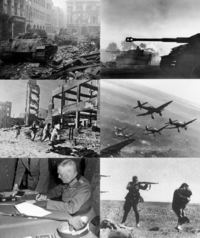
Photo from wikipedia
to interpret the ultimately unique survivor video testimonies, including the challenging task of translating them. Alexander Prenninger’s and David Gramling’s essays at the beginning of the book analyse the power… Click to show full abstract
to interpret the ultimately unique survivor video testimonies, including the challenging task of translating them. Alexander Prenninger’s and David Gramling’s essays at the beginning of the book analyse the power structure within the camp and its connection with language. Prenninger’s essay, based on Bruno Bettelheim, Terence Des Pres and Erving Goffman, shows how survival in incarceration ultimately depended on the ability to adapt to one’s surroundings, including the ability to communicate, whilst Gramling gives an equally well-written insight into the macro-level of language in Nazi Germany in general and the role of the interpreter in the camps in particular. However, the area of how language was used to include or exclude other prisoners from various prisoner groups, so how it was utilized as a potential means of othering, would have been particularly interesting to develop further in this book, especially in relation to the existing scholarship on the camp society by Wolfgang Sofsky, Maja Sunderland, Kim Wünschmann, Anna Hájková et al. Zaia Alexander analyses the Lagersprache through the testimony of Primo Levi and stresses the critical importance of understanding the jargon of the camps. Francine Kaufman’s essay approaches the role of interpreters in films by Claude Lanzman, giving fascinating insights into the aesthetic and technical challenges of depicting their role in a precise manner; however, it does not seem to fully fit into the overall theme of the book. Finally, Viktor Milosevic’s and Piotr Kuhiwzcak’s essays offer an important conclusive consideration about the unique interpretations of the seemingly ineffable camp surroundings, with Milosevic giving an interesting perspective on Soviet camps and therefore an outlook onto potential further comparative research. With this edited collection, Wolf synthesizes a wide range of scholarship on an important and so far under-researched historical topic. It provides an introduction to this research area and will have to be further developed in the future to offer a more comprehensive view of how language worked in violent surroundings generally and various aspects of camp societies specifically.
Journal Title: Social History
Year Published: 2017
Link to full text (if available)
Share on Social Media: Sign Up to like & get
recommendations!